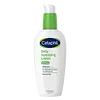What's inside
What's inside
 Key Ingredients
Key Ingredients

 Benefits
Benefits

 Concerns
Concerns

No concerns
 Ingredients Side-by-side
Ingredients Side-by-side

Water
Skin ConditioningDicaprylyl Carbonate
EmollientHydroxyethyl Urea
HumectantCyclopentasiloxane
EmollientGlycerin
HumectantGlyceryl Stearate
EmollientPEG-100 Stearate
Hydrolyzed Hyaluronic Acid
HumectantSodium Hydroxide
BufferingHomarine Hcl
Skin ConditioningSodium PCA
HumectantCetyl Alcohol
EmollientCaprylyl Glycol
EmollientPhenoxyethanol
PreservativeAcrylates/C10-30 Alkyl Acrylate Crosspolymer
Emulsion StabilisingErythritol
HumectantWater
Skin ConditioningPropanediol
SolventHexyldecyl Myristoyl Methylaminopropionate
EmollientIsostearyl Neopentanoate
EmollientGlycerin
HumectantMethyl Trimethicone
Skin ConditioningSea Water
HumectantSaccharide Isomerate
HumectantDimethicone
EmollientPolyacrylate Crosspolymer-6
Emulsion StabilisingTromethamine
BufferingDimethicone/Vinyl Dimethicone Crosspolymer
Skin ConditioningButylene Glycol
HumectantGlyceryl Caprylate
EmollientCarbomer
Emulsion StabilisingAcrylates/C10-30 Alkyl Acrylate Crosspolymer
Emulsion StabilisingDisodium EDTA
Ethylhexylglycerin
Skin Conditioning1,2-Hexanediol
Skin ConditioningParfum
MaskingChenopodium Quinoa Seed Extract
Skin ConditioningMagnesium Sulfate
Calcium Chloride
AstringentPhenoxyethanol
PreservativeSodium Citrate
BufferingCitric Acid
BufferingT-Butyl Alcohol
PerfumingBeta Vulgaris Root Extract
Skin ConditioningManganese Sulfate
Skin ConditioningZinc Sulfate
AntimicrobialBrassica Oleracea Acephala Leaf Extract
HumectantLecithin
EmollientNasturtium Officinale Extract
PerfumingTocopherol
AntioxidantLepidium Sativum Sprout Extract
Skin ConditioningAscorbyl Glucoside
AntioxidantWater, Propanediol, Hexyldecyl Myristoyl Methylaminopropionate, Isostearyl Neopentanoate, Glycerin, Methyl Trimethicone, Sea Water, Saccharide Isomerate, Dimethicone, Polyacrylate Crosspolymer-6, Tromethamine, Dimethicone/Vinyl Dimethicone Crosspolymer, Butylene Glycol, Glyceryl Caprylate, Carbomer, Acrylates/C10-30 Alkyl Acrylate Crosspolymer, Disodium EDTA, Ethylhexylglycerin, 1,2-Hexanediol, Parfum, Chenopodium Quinoa Seed Extract, Magnesium Sulfate, Calcium Chloride, Phenoxyethanol, Sodium Citrate, Citric Acid, T-Butyl Alcohol, Beta Vulgaris Root Extract, Manganese Sulfate, Zinc Sulfate, Brassica Oleracea Acephala Leaf Extract, Lecithin, Nasturtium Officinale Extract, Tocopherol, Lepidium Sativum Sprout Extract, Ascorbyl Glucoside
 Reviews
Reviews

Ingredients Explained
These ingredients are found in both products.
Ingredients higher up in an ingredient list are typically present in a larger amount.
Acrylates/C10-30 Alkyl Acrylate Crosspolymer is a synthetic polymer. It is used to thicken and improve the texture of products. Due to its properties, it can prevent water and oil ingredients from separating.
Glycerin is already naturally found in your skin. It helps moisturize and protect your skin.
A study from 2016 found glycerin to be more effective as a humectant than AHAs and hyaluronic acid.
As a humectant, it helps the skin stay hydrated by pulling moisture to your skin. The low molecular weight of glycerin allows it to pull moisture into the deeper layers of your skin.
Hydrated skin improves your skin barrier; Your skin barrier helps protect against irritants and bacteria.
Glycerin has also been found to have antimicrobial and antiviral properties. Due to these properties, glycerin is often used in wound and burn treatments.
In cosmetics, glycerin is usually derived from plants such as soybean or palm. However, it can also be sourced from animals, such as tallow or animal fat.
This ingredient is organic, colorless, odorless, and non-toxic.
Glycerin is the name for this ingredient in American English. British English uses Glycerol/Glycerine.
Learn more about GlycerinPhenoxyethanol is a preservative that has germicide, antimicrobial, and aromatic properties. Studies show that phenoxyethanol can prevent microbial growth. By itself, it has a scent that is similar to that of a rose.
It's often used in formulations along with Caprylyl Glycol to preserve the shelf life of products.
Water. It's the most common cosmetic ingredient of all. You'll usually see it at the top of ingredient lists, meaning that it makes up the largest part of the product.
So why is it so popular? Water most often acts as a solvent - this means that it helps dissolve other ingredients into the formulation.
You'll also recognize water as that liquid we all need to stay alive. If you see this, drink a glass of water. Stay hydrated!
Learn more about Water